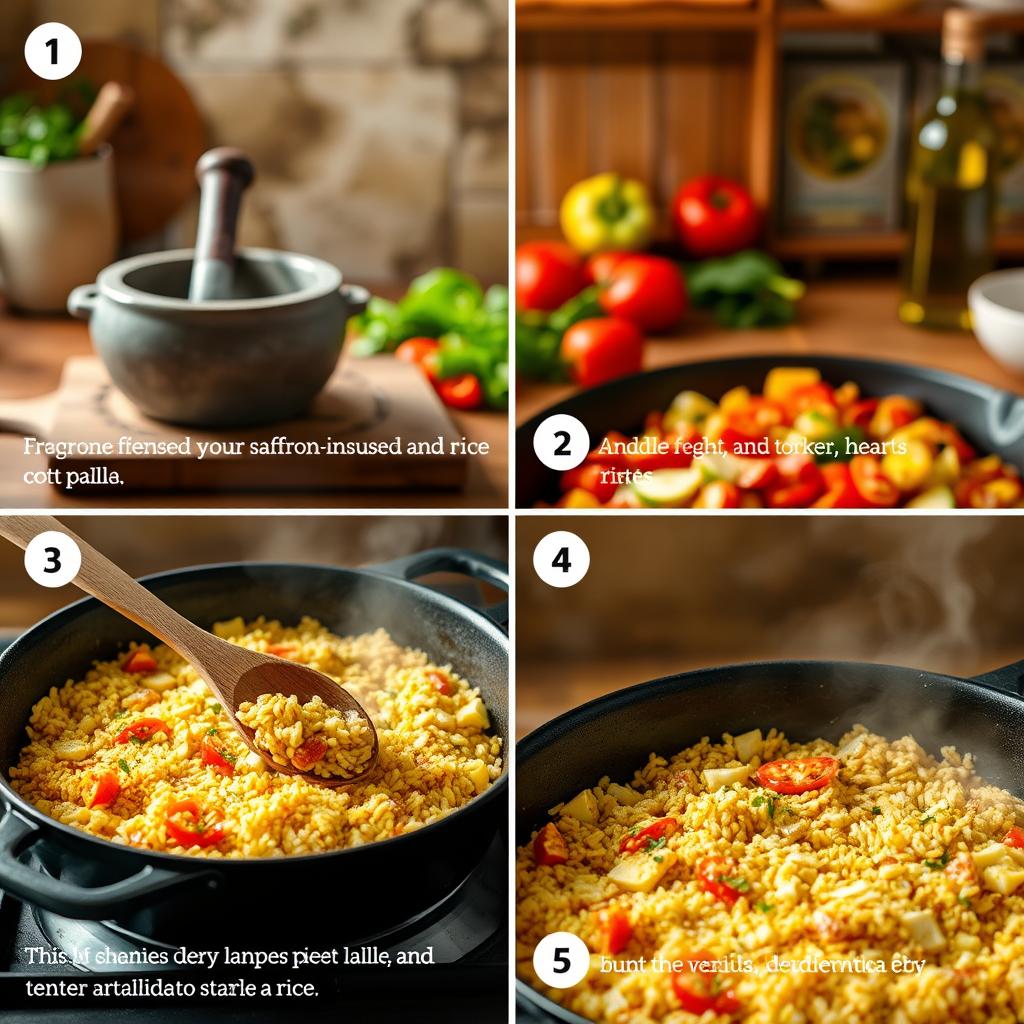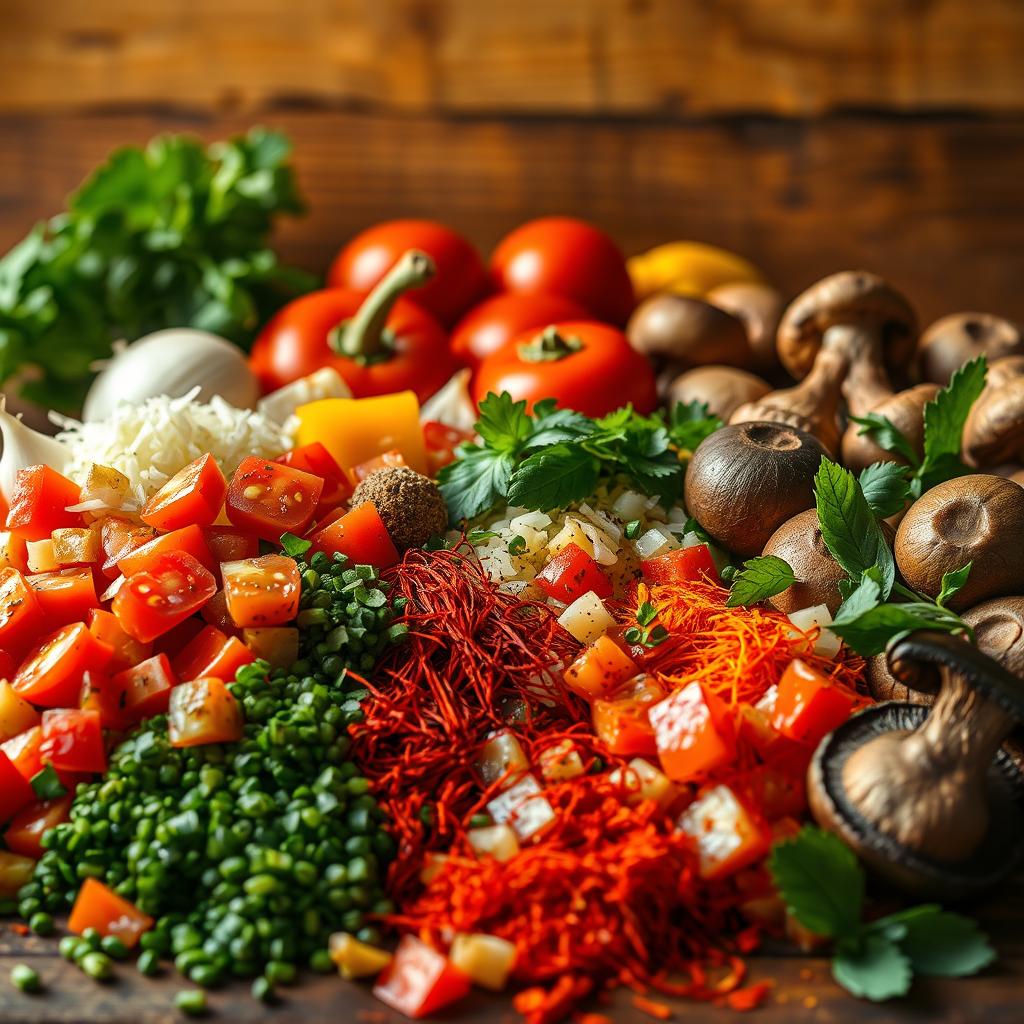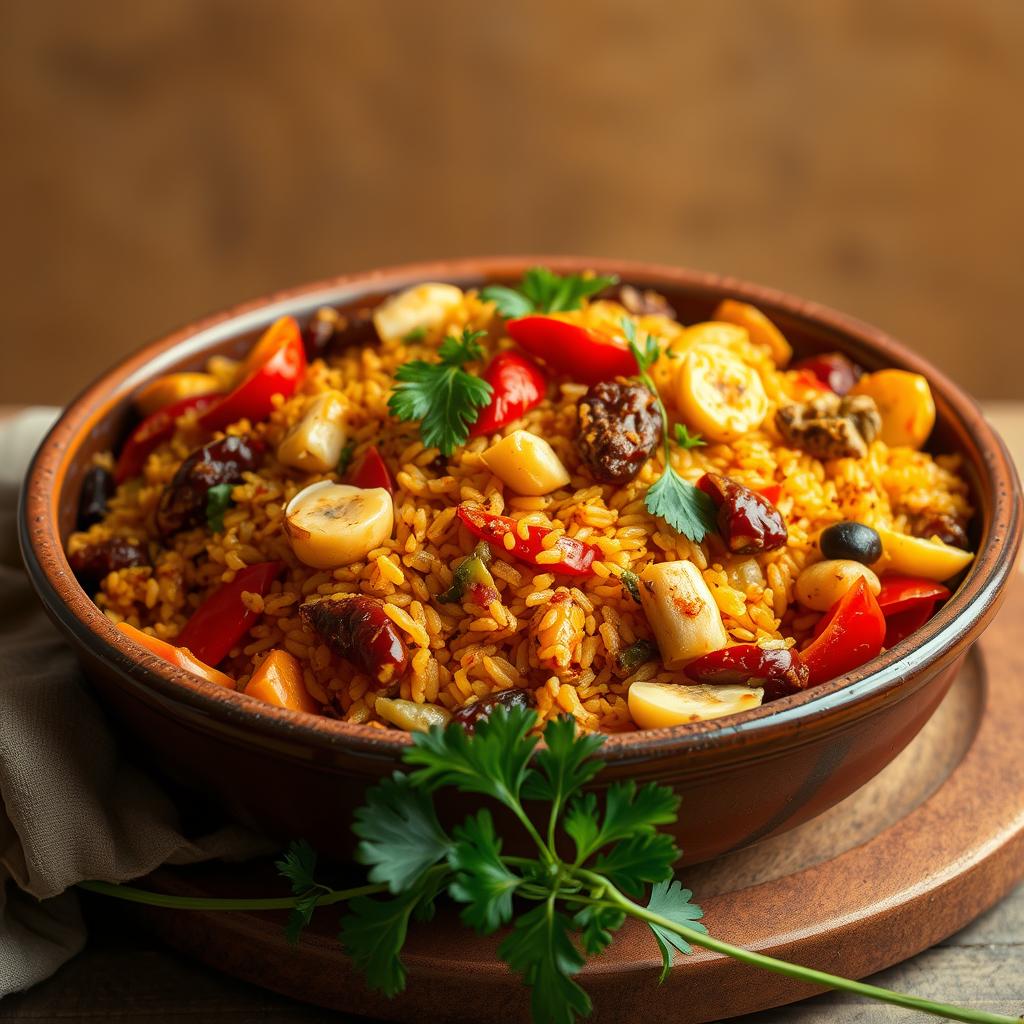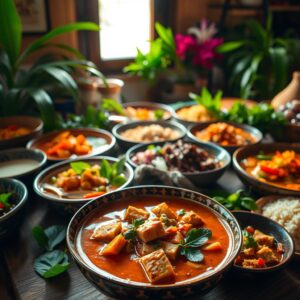Vegan paella recipes can change weeknight dinners into a vibrant, shareable experience.
Have you ever wondered if a plant-based version can capture the same socarrat and bold flavors as the classic dish?
Start with the right rice—Bomba or Calasparra soak up broth and keep texture. Toast the grains briefly, add warm vegetable broth with saffron, and avoid stirring so the layers form.
Use a 12–14 inch stainless-steel pan if you don’t have a paella pan. Sauté onions, red bell pepper, and garlic, then finish with lemon and parsley for bright flavor.
In about 30–40 minutes you can build layers of color, aroma, and a satisfying crust. Links to technique guides like The Spruce Eats and USA Rice help deepen your skills.
Key Takeaways
- Choose high-absorption rice like Bomba or Calasparra for best texture.
- Warm broth with saffron and stop stirring after adding it.
- You can use a stainless-steel skillet in place of a paella pan.
- Listen for snap, crackle, pop to find the socarrat without burning.
- Prep ingredients and time your steps in minutes for stress-free cooking.
Start here: vegan paella recipes that fit your weeknight and weekend cooking
You can make a bright, savory paella-style dinner using one wide pan and pantry staples. Plan 45–60 minutes for a weeknight version and under one hour when you streamline steps. For a relaxed weekend meal, add a splash of white wine and extra layers of flavor.
- For Tuesday night, aim for 45–60 minutes, use a wide skillet you own, and keep the ingredient list short.
- Use short-grain rice (Arborio works) and avoid stirring after you add warm vegetable broth so texture develops.
- Weeknight vegetables: onion, red bell, mushrooms, and frozen peas. Swap zucchini in summer for a fresh boost.
- Keep a kettle of warm broth nearby and control heat so the rice simmers steadily for even cooking.
“Start simple. Build confidence with a basic veggie version before adding artichokes or chickpeas for more body.”
| Pan | Time | Best use |
|---|---|---|
| Wide skillet | 45–60 minutes | Weeknight, even browning |
| 12–14″ stainless pan | 40–60 minutes | Closer to classic texture |
| Outdoor grill | 40–50 minutes | Weekend, smoky flavor |
Resources: For technique, consult The Spruce Eats at https://www.thespruceeats.com/how-to-make-paella-3083520 and for rice selection, see USA Rice at https://www.usarice.com/. These guides help with cup measures, heat control, and broth ratios.
Final note: Start with a basic plan and adjust heat and broth as you learn. In time you’ll nail the socarrat and the right balance of tomatoes, beans, and herbs.
Essential ingredients for authentic flavor and texture
Focus on rice selection and warmed broth to set the foundation for great results. Start with short‑grain rice so grains stay distinct and absorb flavor. Use a clean mise en place: measure cups and teaspoons before you heat the pan.
Choosing the right rice
Bomba rice is ideal: it can absorb up to twice its volume of liquid without turning mushy. Calasparra is another Spanish short‑grain choice that works well.
If those aren’t available, arborio rice is a practical substitute. Toast the rice, add warm liquid, and do not stir after the broth goes in to avoid a risotto texture.
Aromatics and vegetables
Build a base with onion, garlic, and red bell pepper. Add chopped tomatoes and green beans early for body.
Reserve frozen peas to scatter on top at the end for color and a sweet pop.
Broth, saffron, and seasoning
Warm low‑sodium vegetable broth with a teaspoon saffron to coax out aroma and golden color. For budget swaps, a pinch of turmeric gives color with a different taste.
Season with smoked or sweet paprika, finish with olive oil, lemon, salt, and a crack of pepper for balance and bright flavor.
“Choose short-grain rice and warm your broth—those two steps shape everything that follows.”
- Use about 1 cup rice to 2–3 cups broth depending on pan width.
- Add beans or green beans for texture and a plant-protein boost.
- Learn more about saffron threads and buying tips at https://www.seriouseats.com/what-is-saffron.
Step-by-step method to cook paella in about 45 minutes

This 45-minute method guides you from warmed broth to a golden crust with confident timing.
Prep and heat
Warm 3 cups of vegetable broth and steep a teaspoon saffron for aroma before you start. Having hot broth ready keeps the heat steady when you add it to the pan.
Sauté the base
Heat olive oil in your pan over medium. Sauté onions and red bell peppers until soft, then add garlic, chopped tomatoes, and smoked paprika for depth.
Toast the rice
Stir in the rice to coat the grains with oil and toast 1–2 minutes. Toasting locks in flavors and helps the rice cook with separate grains.
Add broth and stop stirring
Pour the hot broth evenly, season with salt and pepper, bring to a strong simmer for 1 minute, then lower the heat and do not stir. Let the rice cook undisturbed for 15–20 minutes.
Create socarrat and rest
In the final minutes listen for a faint snap‑crackle and smell a nutty aroma: that signals the crust forming. If you use an electric range, rotate the pan now and then for even cooking.
Garnish and finish
Scatter peas on top, cover, and let rest 5–8 minutes so steam finishes the rice cook and the crust sets. Finish with lemon wedges and parsley to brighten flavors before serving.
Tools and pans: paella pan vs. your everyday skillet
Choose the right pan and you’ll set yourself up for an even cook and a reliable crust every time.
Why a paella pan helps
A paella pan is wide, shallow, and thin so liquid evaporates fast and contact with heat is maximized.
This design encourages an even socarrat and gives clear aroma cues when the bottom starts to brown.
When a 12–14 inch stainless pan is better
A 12–14″ stainless pan heats evenly and tolerates high heat. Use it when you don’t have a paella pan.
Avoid non‑stick pans; they limit browning and make it hard to judge the developing crust.
Managing heat on gas, grill, and electric
Gas or a grill gives fast, responsive heat so you can control time and temperature easily.
On electric, rotate the pan a couple times during cooking so center and edges finish evenly.
- Keep a thin sheen of oil or olive oil to prevent sticking but still allow color to form.
- Match pan size to servings so the rice layer stays shallow for proper evaporation.
- Preheat the pan and have hot broth ready to avoid stalling the simmer.
| Cookware | Best for | Key tip |
|---|---|---|
| Traditional paella pan | Largest surface, fastest evaporation | Use over open flame or grill for best results |
| 12–14″ stainless pan | Everyday substitute, even heat | Avoid non‑stick; preheat and rotate on electric |
| Non‑stick skillet | Easy cleanup, not ideal | Won’t brown well; skip if you want a crust |
“Good gear shortens the learning curve and helps you sense when the base is ready.”
For step‑by‑step visuals, see The Spruce Eats: https://www.thespruceeats.com/how-to-make-paella-3083520
Vegan paella recipes you can make tonight
Swap complexity for confidence: toast the rice briefly, add hot broth, then let the pan finish the work while you prep a quick garnish.
Classic veggie option
Classic vegetable paella brings together rice, onions, red bell pepper, tomatoes, green beans, and peas. Simmer everything in seasoned broth for under an hour.
Mushroom and artichoke
Use cremini or oyster mushrooms and jarred artichokes. Scent the broth with saffron and smoked paprika, then finish with lemon for bright flavor.
Chickpea and roasted pepper
Add canned chickpeas for extra protein that holds up to heat. Stir in jarred roasted peppers to save time and boost taste. Finish with a parsley‑olive oil drizzle.
- Start with about 1 cup rice and the matching cups of hot broth for your pan size.
- Toast rice 1–2 minutes then do not stir after adding broth to protect texture.
- Store leftovers in an airtight container up to 4 days; reheat gently to preserve the crust.
| Version | Main additions | Finish |
|---|---|---|
| Classic | Peppers, tomatoes, green beans, peas | Lemon wedges, parsley |
| Mushroom & Artichoke | Mushrooms, artichokes, saffron | Smoked paprika, lemon |
| Chickpea & Roasted Pepper | Chickpeas, jarred roasted peppers | Parsley‑olive oil drizzle |
Pro tip: For rice selection and pantry guidance, see U.S. Rice at https://www.usarice.com/.
Flavor upgrades and seasonal swaps

Small swaps give big flavor and make the dish work year-round.
Protein boosters: Add canned chickpeas or white beans to lift protein and iron. Tempeh also holds up well under heat and brings a meaty bite without adding saturated fat.
Seasonal vegetables
In summer fold in zucchini and extra peppers for brightness. In cooler months, use mushrooms and frozen peas so color and texture stay consistent.
Keep a handful of green beans for snap; they contrast the starchy rice and add bite.
Saffron vs. turmeric
Choose saffron for the classic aroma and subtle floral notes. Pick turmeric when cost or availability matters, but expect different flavors and a sharper earthiness.
For saffron background and quality tips, see this guide: Serious Eats on saffron.
- Finish with smoked paprika, lemon, and a parsley‑olive oil drizzle to boost flavor without extra fat.
- Keep heat gentle so vegetables stay vibrant while the rice finishes: build in a little extra resting time to let flavors settle.
| Upgrade | Why use it | When to add |
|---|---|---|
| Chickpeas / white beans | Protein and iron; firm texture | Add with 10–12 minutes left |
| Mushrooms | Umami, hearty winter swap | Sauté early with aromatics |
| Saffron | Classic aroma and golden color | Steep in warm broth before adding |
| Turmeric | Color on a budget; different flavor | Stir into broth at start |
“A thin rice layer and gentle heat let your additions cook evenly and shine.”
Nutrition, storage, and reheating tips
What a serving gives you: A single plate delivers steady energy from short‑grain rice and a good amount of plant protein from beans or chickpeas. You’ll also get notable fiber and a range of vitamins to support an active lifestyle.
What you get per serving: plant protein, iron, fiber, and vitamins
Balance matters: rice supplies complex carbs and B‑vitamins, while legumes and vegetables boost fiber and protein. Iron comes from beans and enriched rice; squeeze lemon at the table to help absorption thanks to vitamin C.
- Fiber: vegetables and legumes help you feel full and aid digestion.
- Protein: plant sources give steady satiety without excess fat when you use olive oil.
- Vitamins & iron: rice contributes B‑vitamins and iron — learn more at USA Rice.
Store and reheat without losing the crust
Transfer leftovers into an airtight container and refrigerate up to four days. Keeping food cold quickly preserves flavor and safety.
To reheat, warm a pan over low heat, add a splash of warm broth, cover, and heat for a few minutes until hot. Uncover at the end to re‑crisp the crust.
If you use a microwave, reheat in short minutes bursts with a damp towel, then finish uncovered or in a hot pan with a little oil to restore texture.
Portion about a cup per serving for lunches; scale cups of rice and vegetables to suit meal prep. Avoid over‑oiling leftovers—just enough to release portions and preserve flavor.
Avoid these common mistakes for perfect results
A few disciplined habits will protect the bottom crust and keep your rice cook on schedule. Follow tight timing and controlled heat to get the texture you expect.
Do not stir after adding broth. Agitation releases starch and turns grains creamy. Once the hot broth is in, lower the heat and let the pan do the work.
Layer and heat matter. Keep a shallow, even rice layer so liquid evaporates uniformly and the crust can form. Too thick a layer traps steam and yields soggy results.
- Manage heat: too high scorches before grains are tender; too low leaves rice underdone.
- On electric, rotate the pan once or twice for even cooking and to avoid underdone edges.
- Add garlic while sautéing; don’t dump it in with the broth where it can taste raw.
- Avoid overloading with red bell and other bell vegetables early; excess water slows evaporation.
- Season with salt when you add the broth, then fine‑tune near the end.
- Keep a small pot of warm vegetable broth at hand to rescue dry spots without shocking the simmer.
“Listen for the faint snap‑crackle and cut the heat at the first hint of burning.”
| Common mistake | What happens | Fix |
|---|---|---|
| Stirring after broth | Creamy, risotto-like rice | Stop stirring; maintain steady low heat |
| Too high heat | Scorched bottom, raw top | Lower burner; watch the minutes closely |
| Thick rice layer | Steam trapped, soggy texture | Spread rice thin across the pan |
Conclusion
Keep the fundamentals front and center: choose short‑grain rice, warm saffron‑infused broth, and control heat so the base forms without stirring. This approach saves you time and sharpens your sense for the socarrat.
Finish simply: use a wide pan or a 12–14″ stainless pan if you don’t own a paella pan. Brighten the plate with lemon and a pinch of pepper to lift the savory flavors.
You’re ready to cook confident, colorful vegan paella that yields tender rice, a golden base, and bold flavors. If you want a quick refresher on technique, see The Spruce Eats: how to make paella. Try one classic recipe tonight, then vary proteins and vegetables as you gain rhythm.




